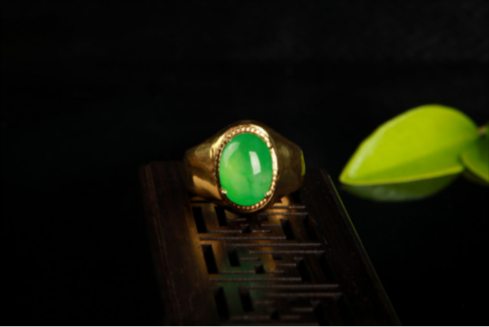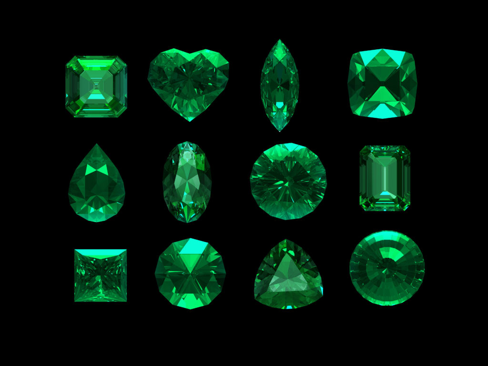
Considering that the per carat value of colored gemstones like emeralds and rubies is growing faster than diamond prices, it may finally be time to rewrite Marilyn Monroe’s 1950’s hit, “Diamonds are a girl’s best friend”. The growing popularity of emeralds in particular was crystal clear at this year’s Golden Globe awards in Hollywood, with a Zambian emerald from the Kagem Mine in Lufwanyama, Copperbelt Province, taking center stage. It was in signet-style ring worn by Oscar winner Mahershala Ali, who won a Golden Globe for his role in the American comedy- drama Green Book. His taste for emerald jewellery was echoed by South African actress Charlize Theron, and several other Hollywood stars.
But celebrity stardom is only one reason that Zambian emeralds have found themselves in the global spotlight. Read on to discover five more.
1. Zambian emeralds are extremely high quality
While Colombia has long been at the forefront when it comes to emerald mining, Zambian emeralds have become increasingly popular in recent years. One reason for this is their extremely high quality and unique appearance.
For a start, Zambian emeralds have a greater level of clarity than their Colombian counterparts because of a lower incidence of “eye-visible inclusions” – such as the presence of noticeable crystals, fissures, or liquid, to name a few of the most commonlyfound inclusions. Zambian emeralds are typically clearer and reflect light much better, enhancing their color and generally making them more aesthetically appealing.
Color is an area in which Zambian emeralds are distinctive. Their highlydesirable bluish undertone comes from the presence of iron in these emeralds. This addition of a little blue adds to the overall depth of the stones.
Zambian emeralds tend to be naturally stronger than others, rating between 7.5 and 8 on the Mohs scale of hardness. This puts them just behind rubies and sapphires (both of which score 9 on the Mohs scale) and diamonds, which score a perfect 10. Zambian emeralds are also less brittle and porous than emeralds from elsewhere in the world.
The durability of Zambian emeralds stems from their origins, and the fact that they were created during millions of years through the process of metamorphic rock coming into contact with granite rock. Colombian emeralds, on the other hand, evolved in sedimentary rock.

2. Zambian emeralds are competitively priced
Even though Zambian emeralds are highly desirable because of their clarity and unique color, they remain a lot more affordable than Colombian stones. The main reason for their generally lower price lies in the history of emerald mining in both countries.
Colombian emerald mining dates back to before the 16th century, and has a pedigree that stretches more than 500 years. In fact, some historians believe that populations indigenous to Colombia were mining the gemstone as early as 300 AD. In contrast, Zambian emeralds were not properly mined until the 1970s.
Essentially, Zambia’s emeralds tend to be less pricey than Colombian stones because they don’t boast as long a history. This makes them a fantastic option for buyers who want a stunning stone at a more affordable price.
3. Zambia has a reputation for producing enormous emeralds
In October 2018, a 5,655-carat (or 1.1kg) emerald was unearthed from Zambia’s Kagem Mine. What made the discovery truly remarkable wasn’t just its size, but its exceptional clarity and perfectly-balanced green hue, with a tinge of golden-yellow.
It was named “Inkalamu”, meaning “lion” in Bemba. The emerald joins an exclusive list of stones that have been given names – an honour reserved only for the rarest and most remarkable gems. In fact, while there are no official records, only around two dozen such stones have ever merited having their own names.
Inkalamu was subsequently auctioned in Singapore a month after its discovery, and while the exact selling price remains unknown, experts peg it at around $2.5 million, making it the most expensive emerald in the world.
But Inkalamu isn’t even the biggest emerald discovered in Zambia. In February 2010, a 6,225-carat emerald was unveiled, again at Kagem Mine. Named “Insofu” – “elephant” in Bemba – this emerald was formed more than 450 million years ago, just like Inkalamu. Both of these glorious emeralds now take pride of place in Indian jewellery brand Diacolor’s collection, while the spotlight continues to shine on Zambian emeralds.
The Inkalamu emerald joins an exclusive list of stones that have been given names, an honour reserved only for the rarest and most remarkable gems.
4. Zambia is home to the world’s largest productive emerald mine
Located in the central part of the Ndola Rural Emerald Restricted Area in Copperbelt Province, and covering an area of approximately 41 square kilometers, Kagem Mine is 75% owned by UK-based mining company Gemfields, and 25% owned by the Industrial Development Corporation of Zambia.
Zambia’s Kagem Mine – where both Inkalamu and Insofu were discovered – is, at present, the world’s single-largest producer of emeralds, accounting for approximately 25% of global production.
In 2018, Kagem produced a staggering 35.5 million carats – approximately 7,100 kilograms – of emerald and beryl. (Emeralds are part of the beryl family of precious stones, also encompassing gems in other colors, like blue). A weight like 35.5 million carats is almost impossible to comprehend; it’s more than 1,000 kilograms heavier than a fully-grown, male African elephant!
5. Zambian emerald production could continue to increase
Zambia’s Minister of Mines, Richard Musukwa, officially opened Gemfields’ 31st auction of emeralds from the Kagem Mine in February 2019 in Lusaka, expressing his commitment to ensuring a stable and predictable fiscal regime to support the mining industry.
Up until May 2019, Kagem had contributed approximately US $107 million in cumulative corporation taxes, mineral royalties and dividends to the Zambian government. That equates to almost 20% of Kagem’s revenues in the last decade.
An August 2019 Gemfields auction in Lusaka – at which predominantly commercial quality rough emeralds were on offer – brought in US$18.6 million. Gemfields confirmed that the stones were extracted by Kagem, and that the proceeds of the auction would therefore be fully repatriated to the Zambia-based company, with the applicable royalties paid to the government.
Zambia’s Kagem Mine – where both Inkalamu and Insofu were discovered – is the world’s single-largest producer of emeralds.
There is hope that the growth trend for emeralds will continue, but a recent report by Edison Investment Research has warned that Zambia’s introduction of a 15% export tax on emeralds in January 2019 has impacted negatively on exploration and development of the industry. The report also points out that coloured gemstones are now selling better than diamonds, which is a real incentive for Zambia to remain competitive within this industry.
One positive step that was recently taken to develop the industry was the Zambian government’s grant of 50 million kwacha ($3.8 million) which will be allocated to 400 small-scale emerald miners whose mineral exploration licenses are currently dormant.
These funds are intended to help overcome the barriers to entry that smaller mining operators often encounter when trying to begin full-time production.
Another positive policy involves miners allocating a percentage of their gemstone auction proceeds to conservation efforts. In the case of Inkalamu, Gemfields divided 10% of its auction proceeds equally between the Zambian Carnivore Programme – which helps conserve large carnivores and their ecosystems in the country – and the Niassa Carnivore Project in Mozambique.
Initiatives like these not only benefit great causes in Zambia and neighbouring countries, but also help to highlight how the mining industry in Zambia is giving back to the country.